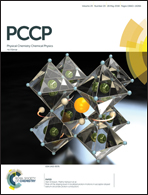Cationic hydrophobicity promotes dissolution of cellulose in aqueous basic solution by freezing–thawing†
Abstract
The physical dissolution of cellulose in aqueous solutions of tetramethyl ammonium hydroxide, triethylmethyl ammonium hydroxide, tetraethyl ammonium hydroxide, benzyltrimethyl ammonium hydroxide, benzyltriethyl ammonium hydroxide, NaOH and LiOH via freezing–thawing was investigated. Increasing the hydrophobicity of the cation greatly improved its dissolution capacity, leading to significant enhancement of cellulose solubility and stability against chain aggregation and gelation. The hydrophobic cations accumulated at the cellulose interface and decreased the surface tension, favouring dispersion of the disintegrated cellulose due to its amphiphilicity; this was consistent with molecular dynamics simulations. On the other hand, the solubility of cellulose followed the Hofmeister series, and cations with greater kosmotropicity originating from their greater hydrophobicity exhibited stronger dissolution power; this observed interaction pattern may be useful for further exploration and designation of novel solvents of cellulose. These aqueous quaternary ammonium hydroxides can be readily recycled and reused, which presents great potential in the green chemistry field.



 Please wait while we load your content...
Please wait while we load your content...